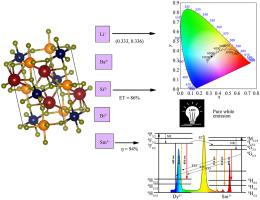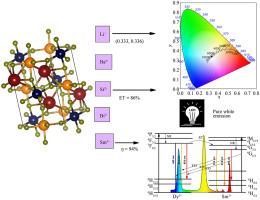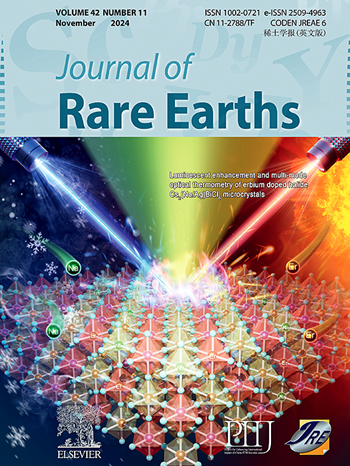Photoluminescence upgradation of La2MgTiO6:2%Dy3+ perovskite with monovalent (Li+), divalent (Ba2+, Sr2+) and trivalent (Bi3+, Sm3+) cation sensitization
IF 7.2
1区 化学
Q1 CHEMISTRY, APPLIED
引用次数: 0
Abstract
Nano phosphors of 2% Dy3+ (wt%) doped La2MgTiO6 and monovalent/divalent/trivalent co-doped La1.98Dy0.02MgTiO6:x%Ay+ (Ay+: Li+, Ba2+, Sr2+, Bi3+, and Sm3+; 0 ≤ x ≤ 2 wt%) were synthesized by combustion method. From the XRD data, it is deduced that an increase in the valency of co-dopant increases the crystallinity of the double perovskite orthorhombic nanocrystal structure. With an increase in co-dopant size, an elevation in optical bandgap is visible with the highest bandgap of 3.835 eV for Bi3+. The photo-absorption is monotonically broadened for Sr2+, Sm3+, and Li+ around 200–450 nm. Under 351 nm, Dy3+ triggered lattice shows major characteristic emission peaks at 480 nm (4F9/2 → 6H15/2), 574 nm (4F9/2 → 6H13/2), and 670 nm (4F9/2 → 6H11/2), leading to near white light emission with CIE coordinates (0.341, 0.376). Upon co-doping, the PL intensity is significantly increased with maximum emission for trivalent Sm3+, followed by divalent Sr2+ and monovalent Li + respectively. With increasing excitation wavelength, Sr2+ shows a dominated output and it is found that divalent Sr2+ is a potential co-dopant that could enhance luminescence intensity up to 6 times with a Sr2+ → Dy3+ energy transfer efficiency of 86%. It is specified that the CIE coordinates of Li+ co-doped samples show ideal white emission with color coordinates (0.333, 0.336). The concluding outcomes signify the noblest rare earth Sm3+ co-doping and thus Sm3+ → Dy3+ energy transfer mechanism is discussed in detail.


一价(Li+)、二价(Ba2+、Sr2+)和三价(Bi3+、Sm3+)阳离子敏化的 La2MgTiO6:2%Dy3+ 包晶的光致发光性能提升
通过燃烧法合成了掺杂 2%Dy3+ (wt%) 的 La2MgTiO6 和单价/二价/三价共掺杂的 La1.98Dy0.02MgTiO6:x%Ay+ (Ay+: Li+, Ba2+, Sr2+, Bi3+, and Sm3+; 0 ≤ x ≤ 2 wt%) 纳米荧光粉。从 XRD 数据可以推断出,随着共掺杂剂价数的增加,双包晶正方体纳米晶体结构的结晶度也随之增加。随着共掺杂剂大小的增加,光带隙明显增大,其中 Bi3+ 的带隙最高,达到 3.835 eV。Sr2+、Sm3+ 和 Li+ 的光吸收在 200-450 纳米附近单调增宽。在 351 纳米波长下,Dy3+ 引发的晶格在 480 纳米波长(4F9/2 → 6H15/2)、574 纳米波长(4F9/2 → 6H13/2)和 670 纳米波长(4F9/2 → 6H11/2)处显示出主要的特征发射峰,从而发出 CIE 坐标为(0.341, 0.376)的近白光。共掺杂后,PL 强度显著增加,三价 Sm3+ 的发射强度最大,其次分别是二价 Sr2+ 和一价 Li+。随着激发波长的增加,Sr2+ 的输出占主导地位,研究发现二价 Sr2+ 是一种潜在的共掺杂剂,可将发光强度提高 6 倍,Sr2+ → Dy3+ 的能量转移效率为 86%。研究明确指出,掺杂 Li+ 的样品的 CIE 坐标显示出理想的白色发射,色坐标为(0.333, 0.336)。这些结论标志着最高级的稀土 Sm3+ 共掺杂,从而详细讨论了 Sm3+ → Dy3+ 的能量传递机制。
本文章由计算机程序翻译,如有差异,请以英文原文为准。
求助全文
约1分钟内获得全文
求助全文
来源期刊

Journal of Rare Earths
化学-应用化学
CiteScore
8.70
自引率
14.30%
发文量
374
审稿时长
1.7 months
期刊介绍:
The Journal of Rare Earths reports studies on the 17 rare earth elements. It is a unique English-language learned journal that publishes works on various aspects of basic theory and applied science in the field of rare earths (RE). The journal accepts original high-quality original research papers and review articles with inventive content, and complete experimental data. It represents high academic standards and new progress in the RE field. Due to the advantage of abundant RE resources of China, the research on RE develops very actively, and papers on the latest progress in this field emerge every year. It is not only an important resource in which technicians publish and obtain their latest research results on RE, but also an important way of reflecting the updated progress in RE research field.
The Journal of Rare Earths covers all research and application of RE rare earths including spectroscopy, luminescence and phosphors, rare earth catalysis, magnetism and magnetic materials, advanced rare earth materials, RE chemistry & hydrometallurgy, RE metallography & pyrometallurgy, RE new materials, RE solid state physics & solid state chemistry, rare earth applications, RE analysis & test, RE geology & ore dressing, etc.
 求助内容:
求助内容: 应助结果提醒方式:
应助结果提醒方式:


